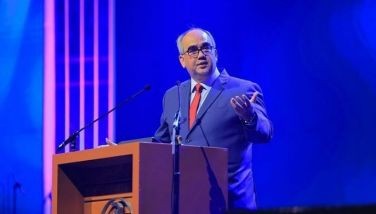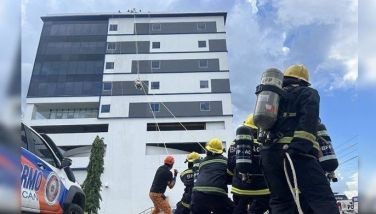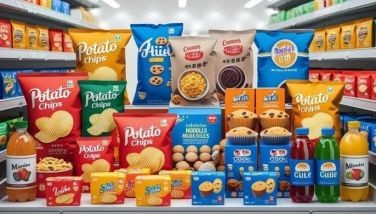Come to the Philippines

Here is a bit of good news coming out of the gloom and doom of Trump’s disastrous tariff increases. The New York Times reports that some Chinese entrepreneurs are seeing the Trump tariffs as a chance to increase the production of their factories in guess where? The Philippines… in Batangas province.
Liu Gang, a Chinese businessman from Dongguan, told the NYT that he is telling companies to “Come to the Philippines” as he showed the NYT’s Shanghai-based business reporter around his Batangas factory stamping out metal parts for Fujitsu A.T.M.s on the factory floor.
Liu told the NYT that “It was hard at first. There weren’t a lot of options for labor. Raw materials like aluminum were three times more expensive than in China. The workers were not as productive as in China.”
Mr. Liu began to move most of his factory production from Dongguan, in southern China, to Batangas in 2018 when Mr. Trump raised tariffs on China during his first term.
So, he and a few others went to the Philippines.
“The Philippines is like China was 15 years ago,” said Kevin Lee, a sales director at HYS Enterprise, which owns a factory in Batangas. “Cheaper labor helped. It costs about $820 a month to employ someone in China; in the Philippines that same worker costs $274.”
The NYT reports that “HYS started shipping two containers’ worth of raw materials from China each week stuffed with plastic pellets, aluminum sheet rolls and bolts and nuts. Mr. Liu brought in Chinese engineers to work with local staff and to start automating some of the manufacturing processes. Business picked up and four years later, in 2022, they bought 20,000 square meters for a third factory that will soon start die casting as well as painting for products like the door panels of Toyota cars…
“The decision to move production to the Philippines from China paid off this week as the Trump administration raised tariffs on Chinese goods to more than 100 percent.”
The NYT surmised that the Philippines may be the only government in the world that has called Mr. Trump’s tariffs “good news.” Trade Secretary Cristina Roque told the media that there is potential gain from the Trump tariff rates and the Philippine government must act fast to take advantage of it.
Suddenly, the NYT reports, “the Philippines is popping up on the radar as companies scramble to find alternatives to their factories in places like Vietnam and Thailand…
“At least half a dozen companies with customers in the United States have made inquiries in the last few weeks with Mr. Liu’s factory and his neighbors in one area of Batangas province that is a 90-minute drive south of Manila. Some have made commitments to shift production. It’s an unexpected turn of events for a country that has long lacked the manufacturing prowess that has pulled many other Asian nations out of poverty.”
But Trump backtracked and paused his tariffs for 90 days except for China. That gives countries like Vietnam time to strike a deal with the US and take away the tariff advantage of the Philippines.
The Philippines is challenging for business, the hardy Chinese investors told the NYT. “Raw materials like rubber and steel are difficult to procure and more expensive than in countries like China. Construction takes longer.”
Not mentioned in the NYT article are other big problems that have been discouraging potential investors: a highly politicized/corrupt business climate, expensive and unreliable power and lately, serious peace and order problems. A Filipino-Chinese businessman had just been kidnapped and, together with his driver, killed presumably after ransom negotiations bogged down.
Still, Mr. Liu is happy enough with his experience to be a good salesman for the Philippines to manufacturers fleeing China’s high tariffs. He is offering his Batangas factory as a “one-stop shop” alternative for factories in neighboring countries, the NYT reports.
“At the Fong Shann Printing factory a few blocks away, four companies with plants in Vietnam, Taiwan and China have visited in recent days to talk about contracting the factory to make the boxing materials for products they will start producing in the Philippines…
“A short drive away in another industrial park, the Japanese medical device company Arkray is making preparations to scale up the manufacturing of its products that get shipped to the US, which include health devices like lactate monitors and diabetes and urinalysis testing devices.”
Philippine trade officials should work with investors already running factories here to convince more manufacturers to come. Potential investors may be more inclined to believe investors with positive experiences in the Philippines.
A PEZA official wrote to me to say that they are now managing 427 ecozones, hosting 4,382 locator companies with actual exports of $48.704 billion from January to October of 2024, and 1,755,807 actual direct employment. “This year, we already approved P175.7 billion investments, on track to achieve our target 15 percent increase in investments.”
There you go… There should be enough locators like Mr. Liu who can help us increase our FDI level which has been pitifully lagging behind our ASEAN peers. Also, the correct measure of the effectiveness of PEZA or BOI in marketing the country is not the number of investments they have approved but the number of investors that have actually put up factories here.
Also, PEZA should have a more ambitious target for future investments than a 15 percent increase. We are in a region of tiger economies. We cannot be mere pussycats. Those Chinese locators interviewed by the NYT are doing a better job of promoting our country.
As I wrote last week, there are opportunities to explore. Government officials responsible for investment promotions and Filipino entrepreneurs should just get off their butts and start selling our potential to companies in ASEAN worried about Trump’s tariff tantrums.
Boo Chanco’s email address is bchanco@gmail.com. Follow him on X @boochanco
- Latest
- Trending





























